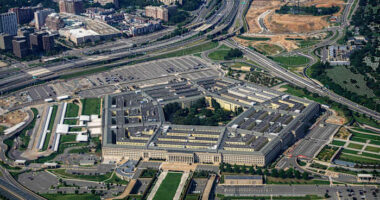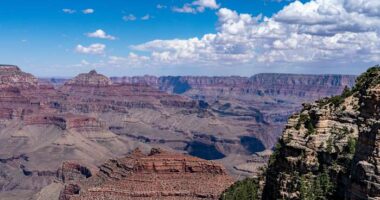Share this @internewscast.com

DUBAI – On early Sunday, the United States targeted three locations in Iran, involving itself in Israel’s mission to dismantle the country’s nuclear capabilities. This bold move is intended to weaken a longstanding adversary but has raised concerns of escalating conflict in the region.
U.S. President Donald Trump claimed in a White House address that Iran’s significant nuclear facilities were “completely and fully obliterated.” However, there has been no independent verification of the damage.
The Atomic Energy Organization of Iran acknowledged attacks on its Fordo, Isfahan, and Natanz sites, stating that its nuclear ambitions will remain unchanged. Both Iran and the U.N. nuclear watchdog reported no immediate evidence of radioactive contamination at the sites that were hit.
It was not clear whether the U.S. would continue attacking Iran alongside its ally Israel, which has been engaged in a war with Iran for nine days. Trump acted without congressional authorization, and he warned that there would be additional strikes if Tehran retaliated against U.S. forces.
“There will either be peace or there will be tragedy for Iran,” he said.
Iran’s top diplomat, Foreign Minister Abbas Araghchi, warned in a post on X that the U.S. attacks “will have everlasting consequences” and that Tehran “reserves all options” to retaliate.
Hours later, Iranian missiles struck areas in northern and central Israel, according to an Israeli rescue service. Initial reports suggested at least 11 people suffered minor injuries.
The US helped Israel strike Iran’s toughest nuclear site
Iran has maintained that its nuclear program is for peaceful purposes only, and U.S. intelligence agencies have assessed that Tehran is not actively pursuing a bomb. However, Trump and Israeli leaders have argued that Iran could quickly assemble a nuclear weapon, making it an imminent threat.
The decision to directly involve the U.S. in the war comes after more than a week of strikes by Israel that significantly degraded Iran’s air defenses and offensive missile capabilities, and damaged its nuclear enrichment facilities. But U.S. and Israeli officials have said American B-2 stealth bombers and the 30,000-pound (13,500-kilogram) bunker-buster bomb that only they have been configured to carry offered the best chance of destroying heavily fortified sites connected to the Iranian nuclear program buried deep underground.
Trump appears to have made the calculation — at the prodding of Israeli officials and many Republican lawmakers — that Israel’s operation had softened the ground and presented a perhaps unparalleled opportunity to set back Iran’s nuclear program, perhaps permanently.
“We have completed our very successful attack on the three Nuclear sites in Iran, including Fordow, Natanz, and Esfahan,” Trump said in a post on social media, using common alternate spellings for two of the sites. “All planes are now outside of Iran air space. A full payload of BOMBS was dropped on the primary site, Fordow. All planes are safely on their way home.”
Trump added in a later post: “This is an HISTORIC MOMENT FOR THE UNITED STATES OF AMERICA, ISRAEL, AND THE WORLD. IRAN MUST NOW AGREE TO END THIS WAR. THANK YOU!”
Israel announced Sunday that it had closed its airspace to both inbound and outbound flights in the wake of the U.S. attacks.
The White House and Pentagon did not immediately elaborate on the operation. U.S. military leaders are scheduled to provide a briefing at 8 a.m. Eastern.
The attack used bunker-buster bombs on Iran’s Fordo nuclear fuel enrichment plant that is built deep into a mountain, a U.S. official said. The weapons are designed to penetrate the ground before exploding. The official spoke on condition of anonymity to discuss military operations.
In addition, U.S. submarines launched about 30 Tomahawk missiles, according to another U.S. official who also spoke on condition of anonymity.
The International Atomic Energy Agency wrote on X that there has been “no increase in off-site radiation levels” after the strikes but that it would continue to monitor the situation.
Trump’s turn to strikes departs from some previous statements
The decision to attack was a risky one for Trump, who won the White House partially on the promise of keeping America out of costly foreign conflicts and scoffed at the value of American interventionism.
But Trump also vowed that he would not allow Iran to obtain a nuclear weapon, and he had initially hoped that the threat of force would bring the country’s leaders to give up its nuclear program peacefully.
For months, Trump said he was dedicated to a diplomatic push to persuade Iran to give up its nuclear ambitions. And he twice — in April and again in late May — persuaded Netanyahu to hold off on military action against Iran and give diplomacy more time.
After Israel began striking Iran, Trump went from publicly expressing hope that the moment could be a “second chance” for Iran to make a deal to delivering explicit threats on Khamenei and making calls for Tehran’s unconditional surrender.
He has bristled at criticism from some supporters who have suggested that further U.S. involvement would be a betrayal to those who were drawn to his promise to end U.S. involvement in expensive and endless wars.
Israeli Prime Minister Benjamin Netanyahu praised Trump’s decision to attack in a video message directed at the American president.
“Your bold decision to target Iran’s nuclear facilities, with the awesome and righteous might of the United States, will change history,” he said. Netanyahu said the U.S. “has done what no other country on earth could do.”
Fears of a broader war
U.N. Secretary-General Antonio Guterres called the strikes a “dangerous escalation,” as world leaders began chiming in with calls for diplomacy.
“There is a growing risk that this conflict could rapidly get out of control — with catastrophic consequences for civilians, the region and the world,” he said in a statement.
Iranian-backed Houthi rebels in Yemen, who had threatened to resume attacks on U.S. vessels in the Red Sea if the Trump administration joined Israel’s military campaign, called on other Muslim nations to form “one front against the Zionist-American arrogance.”
Iran’s Supreme Leader Ayatollah Ali Khamenei had warned the United States on Wednesday that strikes targeting the Islamic Republic will “result in irreparable damage for them.” And Iranian Foreign Ministry spokesman Esmail Baghaei declared “any American intervention would be a recipe for an all-out war in the region.”
The Israeli military said Saturday it was preparing for the possibility of a lengthy war, while Iran’s foreign minister warned before the U.S. attack that American military involvement “would be very, very dangerous for everyone.”
Israeli strikes on Iran have killed at least 865 people and wounded 3,396 others, according to the Washington-based group Human Rights Activists. The group said of those dead, it identified 363 civilians and 215 security force personnel.
Trump’s decision for direct U.S. military intervention comes after his administration made an unsuccessful two-month push — including with high-level, direct negotiations with the Iranians — aimed at persuading Tehran to curb its nuclear program.
During his previous administration, Trump pulled the U.S. unilaterally out of the 2015 nuclear deal with Iran, prompting Tehran to begin enriching uranium to higher levels and restrict the access of IAEA inspectors to its facilities.
___
Madhani reported from Morristown, N.J. Associated Press writers Nasser Karimi, Mehdi Fattahi and Amir Vahdat in Iran; Julia Frankel in Jerusalem; Lolita Baldor in Narragansett, Rhode Island; and Samy Magdy in Cairo contributed to this story.
Copyright 2025 The Associated Press. All rights reserved. This material may not be published, broadcast, rewritten or redistributed without permission.











